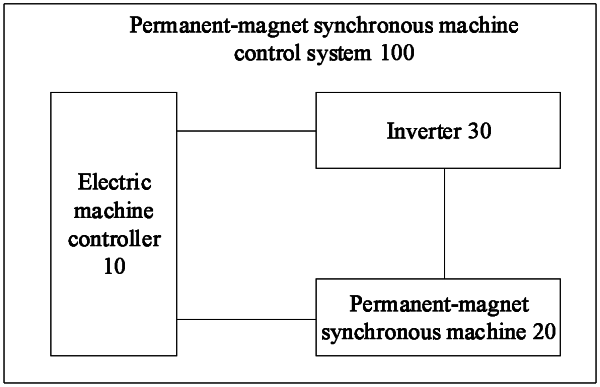| CPC H02P 21/05 (2013.01) [H02P 6/10 (2013.01); H02P 21/22 (2016.02); H02P 2207/05 (2013.01)] | 10 Claims |

|
1. A permanent-magnet synchronous machine control method, comprising:
obtaining a d-axis current id and a q-axis current iq in a permanent-magnet synchronous machine control loop at a current moment;
obtaining a fifth-order harmonic current id5th and a seventh-order harmonic current id7th in the d-axis current id in the permanent-magnet synchronous machine control loop at the current moment, and a fifth-order harmonic current iq5th and a seventh-order harmonic current iq7th in the q-axis current iq in the permanent-magnet synchronous machine loop at the current moment;
calculating four harmonic voltages based on the fifth-order harmonic current id5th, the seventh-order harmonic current id7th, the fifth-order harmonic current iq5th, and the seventh-order harmonic current iq7th, wherein the four harmonic voltages comprise a d-axis-fifth-order harmonic voltage ud5th, a q-axis fifth-order harmonic voltage uq5th, a d-axis seventh-order harmonic voltage ud7th, and a q-axis seventh-order harmonic voltage uq7th;
subtracting the fifth-order harmonic current id5th and the seventh-order harmonic current id7th from the d-axis current id to obtain a first current idk on a d axis; and subtracting the fifth-order harmonic current iq5th and the seventh-order harmonic current iq7th from the q-axis current iq to obtain a second current iqk on a q axis;
subtracting the d-axis fifth-order harmonic voltage ud5th and the d-axis seventh-order harmonic voltage ud7th from a d-axis voltage corresponding to each switch state of an inverter to obtain a first voltage on the d axis in each switch state, and subtracting the q-axis fifth-order harmonic voltage uq5th and the q-axis seventh-order harmonic voltage uq7th from a q-axis voltage corresponding to each switch state of the inverter to obtain a second voltage on the q axis in each switch state;
determining a d-axis current idk+1 at a next moment in each switch state based on the first current idk, the second current iqk, and the first voltage in each switch state; and determining a q-axis current iqk+1 at the next moment in each switch state based on the first current idk, the second current iqk, and the second voltage in each switch state; and
determining a control policy of the permanent-magnet synchronous machine based on the d-axis current idk+1 at the next moment in each switch state and the q-axis current iqk+1 at the next moment in each switch state.
|
|
6. A permanent-magnet synchronous machine control device, characterized in that the device comprises:
a first obtaining module, configured to obtain a d-axis current id and a q-axis current iq in a permanent-magnet synchronous machine control loop at a current moment;
a second obtaining module, configured to obtain a fifth-order harmonic current id5th and a seventh-order harmonic current id7th in the d-axis current id in the permanent-magnet synchronous machine control loop at the current moment, and a fifth-order harmonic current iq5th and a seventh-order harmonic current iq7th in the q-axis current in the permanent-magnet synchronous machine loop at the current moment;
a first calculation module, configured to calculate four harmonic voltages based on the fifth-order harmonic current id5th, the seventh-order harmonic current id7th, the fifth-order harmonic current iq5th, and the seventh-order harmonic current iq7th, wherein the four harmonic voltages comprise a d-axis fifth-order harmonic voltage ud5th, a q-axis fifth-order harmonic voltage uq5th, a d-axis seventh-order harmonic voltage ud7th, and a q-axis seventh-order harmonic voltage uq7th;
a second calculation module, configured to subtract the fifth-order harmonic current id5th and the seventh-order harmonic current id7th from the d-axis current id to obtain a first current idk on a d axis; and subtract the fifth-order harmonic current iq5th and the seventh-order harmonic current iq7th from the q-axis current iq to obtain a second current iqk on a q axis;
a third calculation module, configured to subtract the d-axis fifth-order harmonic voltage ud5th and the d-axis seventh-order harmonic voltage ud7th from a d-axis voltage corresponding to each switch state of an inverter to obtain a first voltage on the d axis in each switch state; and subtract the q-axis fifth-order harmonic voltage uq5th and the q-axis seventh-order harmonic voltage uq7th from a q-axis voltage corresponding to each switch state of the inverter to obtain a second voltage on the q axis in each switch state;
a fourth calculation module, configured to determine a d-axis current idk+1 at a next moment in each switch state based on the first current idk, the second current iqk, and the first voltage in each switch state; and determine a q-axis current iqk+1 at the next moment in each switch state based on the first current idk, the second current iqk, and the second voltage in each switch state; and
a determining module, configured to determine a control policy of the permanent-magnet synchronous machine based on the d-axis current idk+1 at the next moment in each switch state and the q-axis current iqk+1 at the next moment in each switch state.
|